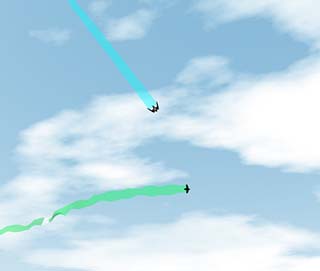Extremely Fast Dives Help Peregrine Falcons Maneuver to Catch Agile Prey
Computer simulations of peregrine falcon attacks show that the extreme speeds reached during dives from high altitudes enhance the raptors’ ability to execute maneuvers needed to nab agile prey that would otherwise escape. Robin Mills and colleagues of the University of Groningen, Netherlands, and Oxford University, UK, report this discovery in PLOS Computational Biology.
By attaching video cameras and GPS trackers on a Peregrine falcon, prior research by the team showed that falcons attack their prey using the same steering rules as man-made missiles. But it remained unknown why peregrine falcons choose to catch prey by diving from great heights at speeds faster than any other animal. Such risky behavior surely places extraordinary physical and cognitive demands on the falcon.
Computer simulation
To investigate the peregrine’s dive strategy, Mills and colleagues built a physics-based computer simulation of bird flight that pits falcons against prey. The simulation incorporates the aerodynamics of bird flight, how birds flap and tuck their wings, how falcons perceive their prey and react to it with delay and how falcons target their prey like a missile.
Maneuvering
By running the simulation millions of times, varying the falcon’s attack strategy each time, the researchers showed that high-speed dives enable peregrines to produce much higher aerodynamic forces for maneuvering, thereby maximizing their chance of seizing agile prey.
The stoop
Still, the simulation showed, high-speed dives require very precisely tuned steering for a falcon to attack successfully, revealing that the stoop is a highly specialist hunting technique. The research team found that optimal tuning of the mathematical laws that control steering in the simulation corresponded closely to measurements of steering for real falcons.
Unique attack strategies
The research team is now extending their simulation to explore why different raptor species, including the goshawk and the sparrow hawk, have unique attack strategies, and to identify why different raptors often specialize on different types of prey. They are also studying the best escape tactics that prey can employ to evade capture.
Fastest on Earth
“Our simulations reveal why peregrines have evolved to dive from great heights, and at speeds faster than any other animal,” Mills says. “Ultimately, we aim to understand the arms race between aerial predators and their prey that has led raptors to become some of the fastest and most agile animals on Earth.”
More information
- Physics-based simulations of aerial attacks by peregrine falcons reveal that stooping at high speed maximizes catch success against agile prey - Mills R, Hildenbrandt H, Taylor GK, Hemelrijk CK (2018) - PLoS Computational Biology 14(4): e1006044. https://doi.org/10.1371/journal.pcbi.1006044 / http://journals.plos.org/ploscompbiol/article?id=10.1371/journal.pcbi.1006044
- Funding: The project grant for the PhD position of Robin Mills was provided by Nederlandse Organisatie voor Wetenschappelijk Onderzoek (NWO; file 823.01.017) to CKH. This project has received funding from the European Research Council (ERC) under the European Union's Horizon 2020 research and innovation programme (grant agreement No 682501) to GKT. Funding for research exchange has been provided by the Dobberke foundation. The funders had no role in study design, data collection and analysis, decision to publish, or preparation of the manuscript.
Image Caption
The image is a snapshot of the simulation in action. A stooping peregrine falcon (blue trajectory) is about to intercept a common starling (green trajectory) that maneuvers erratically to evade.

| Last modified: | 23 May 2018 12.38 p.m. |
More news
-
29 April 2024
Tactile sensors
Every two weeks, UG Makers puts the spotlight on a researcher who has created something tangible, ranging from homemade measuring equipment for academic research to small or larger products that can change our daily lives. That is how UG...
-
16 April 2024
UG signs Barcelona Declaration on Open Research Information
In a significant stride toward advancing responsible research assessment and open science, the University of Groningen has officially signed the Barcelona Declaration on Open Research Information.
-
02 April 2024
Flying on wood dust
Every two weeks, UG Makers puts the spotlight on a researcher who has created something tangible, ranging from homemade measuring equipment for academic research to small or larger products that can change our daily lives. That is how UG...
